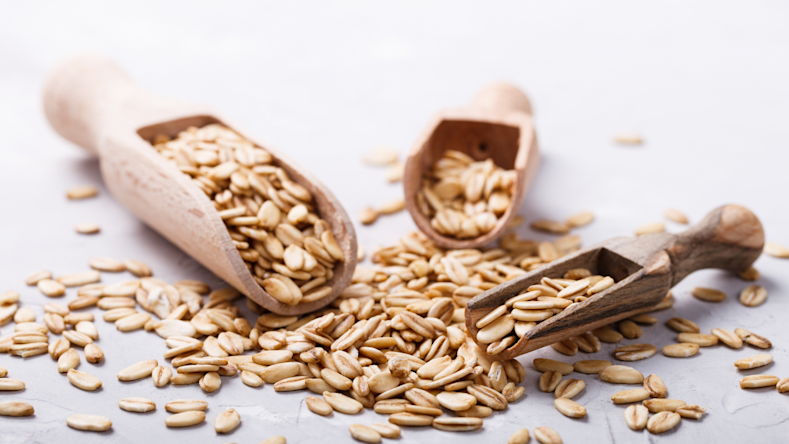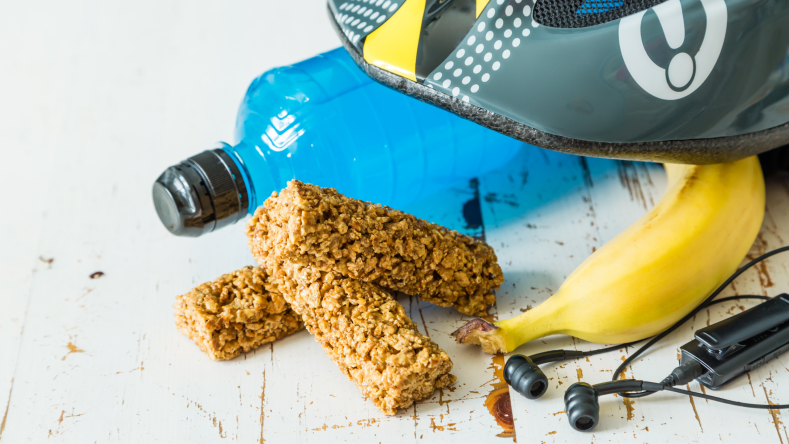Busting nutrition myths on carbohydrates
Carbohydrates have been demonized for years, but are they really as bad as everyone makes them out to be? Here’s what you need to know about carbs and the nutrition myths surrounding them.

Thanks to the rise of low-carb diets and a culture obsessed with weight loss, carbohydrates have been hailed as nutrition public enemy #1. As a result, this macronutrient has become a no-no for people wanting to shed fat, boost performance, and improve sleep habits. But is this fear of carbohydrates really warranted? We’re diving into the research to determine if carbs are as bad as everyone makes them out to be.

Myth: All carbohydrates are bad for your health.
Reality: Complex carbs have multiple health benefits and can even extend your life.
First and foremost, let’s distinguish between different types of carbohydrates. Not all carbs are created equal. While some have health benefits, others can contribute to chronic disease, which is why the quality of carbohydrates you consume is just as important as the quantity [ 1
Simple carbohydrates.
Otherwise referred to as “fast acting carbs”, simple carbohydrates are broken down quickly by the body to be used as energy. While they naturally occur in dairy products and fruits (known as natural sugars), they are often added to foods in the form of refined sugars.
These refined sugars spike (and crash) your blood sugar�–which can leave you feeling irritable, hungry, and tired–as well as contribute a large number of calories without adequate nutrition or feelings of fullness. Since they have little nutritional value, diets high in refined (or added) sugars can increase your risk of diabetes, obesity, heart disease, cancer, and cognitive decline [ 2
Some dietary sources include:
Fruits
Dairy products
Candy
Sugary beverages
Products with added sugars
Cookies
Breakfast cereals
Fruit juice concentrate
Complex carbohydrates.
Complex carbohydrates are composed of long chains of sugar molecules that take longer to digest, and hence, produce a steady supply of energy-fueling glucose that gets released more slowly over an extended period of time.
Foods that contain complex carbohydrates are often less refined than their counterparts with added, simple sugars, and provide a higher nutritional value due to the presence of vitamins, minerals, and fiber 3 4 5
Some dietary sources include:
Whole grains (quinoa, barley, brown rice, popcorn, and oats)
Legumes (lentils, chickpeas, kidney beans, green peas, and split peas)
Starchy vegetables (potatoes, sweet potatoes, and corn)
High fiber fruits (berries, avocado, guava, bananas, oranges and apples)

Myth: You shouldn’t eat carbs before exercise.
Reality: Carbohydrates are a primary source of energy and, if tolerated, should be part of your pre-workout nutrition strategy.
Whether you’re an elite athlete or recreational gym-goer, carbohydrates should be included as part of your pre-workout nutrition strategy to top off glycogen stores and provide readily-available fuel for working muscles [ 6 7
Blood glucose and muscle glycogen (stored carbohydrates) are the most important substrates for contracting muscles in endurance activity [ 8 9 10
However, some people may feel sluggish or nauseous if they eat prior to exercise. So, if this is the case for you, it may be helpful to allow more time for your food to digest before working out. Additionally, if you have a sensitive stomach, you could try consuming higher glycemic index carbs (such as sports drinks, gels, white bread, bagels, pasta, cereals, and juice), as these are rapidly digested and absorbed.
Here are some carb-filled nutrition suggestions to fuel your workout:
Protein smoothie made with milk, protein powder, banana and mixed berries
Whole-grain cereal and milk
A cup of oatmeal topped with banana and sliced almonds
Natural almond butter and fruit preserve sandwich on whole-grain bread
Greek yogurt and fruit
Nutrition bar with protein and wholesome ingredients
A piece of fruit, such as a banana, orange or apple
Myth: People with diabetes shouldn’t consume carbs.
Reality: When closely monitored, carbohydrates can be a healthful addition to any diet.
According to the Center for Disease Control (CDC), people with diabetes should aim to eat about 50% of their calories from carbohydrates [ 11
Complex carbs have starch and fiber, both of which may offer benefits for those with diabetes. For instance, starch, a polysaccharide consisting of several glucose molecules connected in a chain and often found in several vegetables and whole grains, has been found to slow the release of glucose into the blood and prevent blood sugar spikes [ 12
Fiber can also increase insulin sensitivity, decrease blood pressure and cholesterol, and aid with weight loss, all of which are important for people with diabetes [ 13 14
However, if you have diabetes, you should closely monitor blood sugar levels and regulate your carb intake based on the results.
Myth: You can’t lose weight while eating carbs.
Reality: Complex carbohydrates are part of a healthy weight loss strategy, and can be used to maintain weight.
Complex carbohydrates are higher in fiber, which can help improve satiety and keep you fuller longer, thus aiding in appetite and weight control [ 15 16
Studies show that adults who ate several servings of whole grains a day gained less weight when compared to those who rarely ate whole grains [ 17 18
The American Heart Association recommends a total dietary fiber intake of 25 to 30 g/day, with that range nearing 38 grams a day for men under 50 [ 26 24 25
Some high fiber carbs that are beneficial for weight loss (and maintenance) include:
Quinoa
Oats
Sweet potatoes
Cruciferous vegetables (broccoli, cauliflower, and brussels sprouts)
Legumes
Berries

Myth: Fruit has too much sugar.
Reality: Fruit contains natural sugars, which have been shown to offer multiple health benefits.
Fruit isn’t your enemy! While it’s a natural source of fructose (a simple carbohydrate), it also provides a plethora of vitamins, minerals, and fiber that contribute to overall health.
However, like carbohydrates, not all sugar is created equal, as the effect it can have on your body depends on what type you’re eating. Here’s a brief breakdown of the difference between refined sugar and natural sugar.
Refined sugar.
This type of sugar is processed from sugar cane or sugar beets and is typically found as sucrose (a combination of glucose and fructose). Unlike naturally occurring sugars in whole foods that are typically paired with fiber and/or protein to slow digestion, refined sugars are typically not paired with fiber or protein. Hence, your body rapidly breaks down refined sugars causing insulin and blood sugar levels to spike. Additionally, refined sugars (found in processed foods, sodas, fruit juices, pastries, candy, and more) contribute a large number of calories but have little nutritional value otherwise [ 19 20
Natural sugar.
As the name suggests, these sugars occur naturally in fruit (fructose), vegetables, grains, and dairy products (lactose). Thanks to the fiber and protein present in these foods, the natural sugars are digested and absorbed into the bloodstream at a slower rate, thus providing a steady supply of energy to your cells and a more balanced blood sugar response. They also contain other essential nutrients–like vitamins, minerals, and antioxidants–that are needed for energy metabolism, immune function, cell health, and more.
A diet rich in fruits and vegetables can help reduce the risk of chronic diseases, such as diabetes, heart disease, and some cancers.
Myth: Athletes should avoid carbs.
Reality: Carbohydrates are an essential nutrient for any type of athlete.
Carbohydrates are the most efficient macronutrient group for working muscles because they provide quick, usable energy and help load and replenish muscle glycogen stores [ 21 pre- and post-workout nutrition strategy
Carbohydrates are classified as either high-glycemic (rapidly digested and absorbed) or low glycemic (slowly digested and absorbed), and both can be helpful in an athlete’s diet depending on the situation.
While high fiber, low glycemic carbohydrates offer more health benefits than refined, high glycemic carbohydrate choices, the latter may be beneficial closer to exercise–especially for those with sensitive stomachs. For instance, high glycemic carbohydrates (such as sports drinks, juice, and gels) can be useful immediately before, during, and after exercise to minimize GI distress, speed up recovery and provide quick energy [ 22 23
Some good carbohydrate-rich foods for athletes include:
Whole grains (rolled oats, rice, farro, barley, quinoa, sprouted grain bread, granola)
Starchy vegetables (sweet potato, potato, squash)
Fruit
Dried fruit
Nutrition bar with >25g carb and <5g fiber per serving
Higher glycemic refined grains (white bread, bagels, pasta, cereals, and juice)
Summary
Carbohydrates have been demonized for years thanks to the rise of low-carb diets and a culture obsessed with weight loss. While this macronutrient has been public enemy #1, it doesn’t have to be. Complex carbohydrates (such as whole grains, vegetables and legumes) are filled with vitamins, minerals, and fiber–all of which have been shown to reduce the risk of chronic disease, help with weight loss, stabilize blood sugar levels, and replenish muscle glycogen stores. However, not all carbs are created equal, so it’s recommended to limit simple carbs (in the form of refined sugars) and focus on consuming a variety of complex carbohydrates.
Disclaimer: The text, images, videos, and other media on this page are provided for informational purposes only and are not intended to treat, diagnose or replace personalized medical care.
Key takeaways
Studies have found that complex carbs play a key role in digestion and regular bowel movements, cholesterol maintenance, weight management, blood sugar regulation, and longevity [
3
,4
,5
].Carbohydrates should be included as part of your pre-workout nutrition strategy to top off glycogen stores and provide readily-available fuel for working muscles [
6
,7
].The starch and fiber in complex carbs can increase insulin sensitivity, decrease blood pressure and cholesterol, and aid with weight loss, all of which are important for people with diabetes [
13
,14
].Fruit contains natural sugars and other essential nutrients–like vitamins, minerals, and antioxidants–that are needed for energy metabolism, immune function, cell health, and more.
Research has found that dietary fiber intake promotes weight loss and increases the ability to stick to a calorie-restricted diet in overweight or obese adults [
18
].
References:
Kanter M. (2018). High-Quality Carbohydrates and Physical Performance: Expert Panel Report. Nutrition today, 53(1), 35–39.
https://doi.org/10.1097/NT.0000000000000238
L;, P. (n.d.). The sweet danger of added sugars. European journal of paediatric dentistry. Retrieved May 12, 2022, from
https://pubmed.ncbi.nlm.nih.gov/31246081/
Barrea, L., Arnone, A., Annunziata, G., Muscogiuri, G., Laudisio, D., Salzano, C., Pugliese, G., Colao, A., & Savastano, S. (2019). Adherence to the Mediterranean Diet, Dietary Patterns and Body Composition in Women with Polycystic Ovary Syndrome (PCOS). Nutrients, 11(10), 2278.
https://doi.org/10.3390/nu11102278
Reynolds, A., Mann, J., Cummings, J., Winter, N., Mete, E., & Te Morenga, L. (2019). Carbohydrate quality and human health: A series of systematic reviews and meta-analyses. The Lancet, 393(10170), 434–445.
https://doi.org/10.1016/s0140-6736(18)31809-9
Lattimer, J. M., & Haub, M. D. (2010). Effects of dietary fiber and its components on metabolic health. Nutrients, 2(12), 1266–1289.
https://doi.org/10.3390/nu2121266
Jeukendrup A. (2014). A step towards personalized sports nutrition: carbohydrate intake during exercise. Sports medicine (Auckland, N.Z.), 44 Suppl 1(Suppl 1), S25–S33.
https://doi.org/10.1007/s40279-014-0148-z
Bussau, V. A., Fairchild, T. J., Rao, A., Steele, P., & Fournier, P. A. (2002). Carbohydrate loading in human muscle: an improved 1 day protocol. European journal of applied physiology, 87(3), 290–295.
https://doi.org/10.1007/s00421-002-0621-5
Brooke, N. K., & Cosio-Lima, L. (2022). Nutrition in cycling. Physical Medicine and Rehabilitation Clinics of North America, 33(1), 159–172.
https://doi.org/10.1016/j.pmr.2021.08.011
Jeukendrup, A. E. (2011). Nutrition for endurance sports: Marathon, triathlon, and road cycling. Journal of Sports Sciences, 29(sup1).
https://doi.org/10.1080/02640414.2011.610348
Aird, T. P., Davies, R. W., & Carson, B. P. (2018). Effects of fasted vs fed-state exercise on performance and post-exercise metabolism: A systematic review and meta-analysis. Scandinavian journal of medicine & science in sports, 28(5), 1476–1493.
https://doi.org/10.1111/sms.13054
Centers for Disease Control and Prevention. (2021, August 10). Carb counting. Centers for Disease Control and Prevention. Retrieved May 12, 2022, from
https://www.cdc.gov/diabetes/managing/eat-well/diabetes-and-carbohydrates.html
Lee, B. H., Eskandari, R., Jones, K., Reddy, K. R., Quezada-Calvillo, R., Nichols, B. L., Rose, D. R., Hamaker, B. R., & Pinto, B. M. (2012). Modulation of starch digestion for slow glucose release through "toggling" of activities of mucosal α-glucosidases. The Journal of biological chemistry, 287(38), 31929–31938.
https://doi.org/10.1074/jbc.M112.351858
Dong, Y., Chen, L., Gutin, B., & Zhu, H. (2019). Total, insoluble, and soluble dietary fiber intake and insulin resistance and blood pressure in adolescents. European journal of clinical nutrition, 73(8), 1172–1178.
https://doi.org/10.1038/s41430-018-0372-y
Aleixandre, A., & Miguel, M. (2016). Dietary fiber and blood pressure control. Food & function, 7(4), 1864–1871.
https://doi.org/10.1039/c5fo00950b
Greenhill, C. (2016). Fermentable carbohydrates increase satiety signals. Nature Reviews Endocrinology, 13(1), 3–3.
https://doi.org/10.1038/nrendo.2016.199
Pan, A., & Hu, F. B. (2011). Effects of carbohydrates on satiety: differences between liquid and solid food. Current opinion in clinical nutrition and metabolic care, 14(4), 385–390.
https://doi.org/10.1097/MCO.0b013e328346df36
Tufts University, Health Sciences Campus. (2021, July 13). Eating whole grains linked to smaller increases in waist size, blood pressure, blood sugar: Study in middle- to older-aged adults suggests whole grains may protect against heart disease. ScienceDaily. Retrieved May 11, 2022 from
www.sciencedaily.com/releases/2021/07/210713165308.htm
Miketinas, D. C., Bray, G. A., Beyl, R. A., Ryan, D. H., Sacks, F. M., & Champagne, C. M. (2019). Fiber intake predicts weight loss and dietary adherence in adults consuming calorie-restricted diets: The pounds lost (preventing overweight using novel dietary strategies) study. The Journal of Nutrition, 149(10), 1742–1748.
https://doi.org/10.1093/jn/nxz117
DiNicolantonio, J. J., & Berger, A. (2016). Added sugars drive nutrient and energy deficit in obesity: a new paradigm. Open heart, 3(2), e000469.
https://doi.org/10.1136/openhrt-2016-000469
Rippe, J., & Angelopoulos, T. (2016). Relationship between added sugars consumption and chronic disease risk factors: Current understanding. Nutrients, 8(11), 697.
https://doi.org/10.3390/nu8110697
Kanter M. (2018). High-Quality Carbohydrates and Physical Performance: Expert Panel Report. Nutrition today, 53(1), 35–39.
https://doi.org/10.1097/NT.0000000000000238
Mata, F., Valenzuela, P. L., Gimenez, J., Tur, C., Ferreria, D., Domínguez, R., Sanchez-Oliver, A. J., & Martínez Sanz, J. M. (2019). Carbohydrate availability and physical performance: Physiological overview and practical recommendations. Nutrients, 11(5), 1084.
https://doi.org/10.3390/nu11051084
Burke, L. M., van Loon, L. J., & Hawley, J. A. (2017). Postexercise muscle glycogen resynthesis in humans. Journal of Applied Physiology, 122(5), 1055–1067.
https://doi.org/10.1152/japplphysiol.00860.2016
Hoy, K., & Goldman, J. (2014, September). Fiber intake of the U.S. population. Retrieved May 13, 2022, from
https://www.ars.usda.gov/arsuserfiles/80400530/pdf/dbrief/12_fiber_intake_0910.pdf
.Ma, Y., Olendzki, B. C., Wang, J., Persuitte, G. M., Li, W., Fang, H., Merriam, P. A., Wedick, N. M., Ockene, I. S., Culver, A. L., Schneider, K. L., Olendzki, G. F., Carmody, J., Ge, T., Zhang, Z., & Pagoto, S. L. (2015). Single-component versus multicomponent dietary goals for the metabolic syndrome: a randomized trial. Annals of internal medicine, 162(4), 248–257.
https://doi.org/10.7326/M14-0611
Turner, N. D., & Lupton, J. R. (2011). Dietary fiber. Advances in nutrition (Bethesda, Md.), 2(2), 151–152.
https://doi.org/10.3945/an.110.000281






